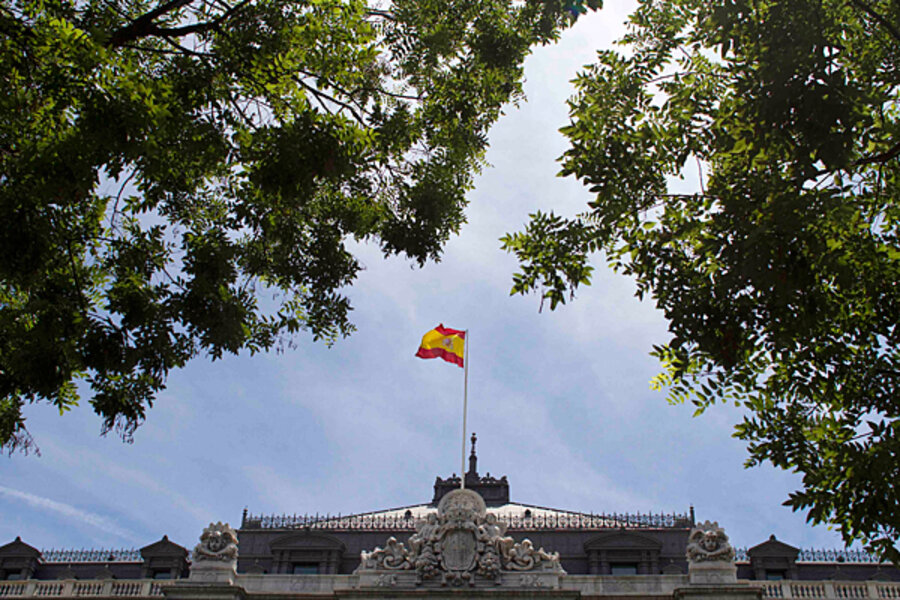Spain's empty townhouses and Obama's reelection bid: what's the link?
Loading...
| Washington
As we drove out of Madrid on the autovia toward our destination in northern Spain, the abandoned, sometimes half-built housing complexes greeted us sadly to the right and left, one after the other.
I’d read about the new but eerily lifeless subdivisions of Las Vegas and central Florida, the ghosts of the American housing collapse of 2007. But the sight of all those empty monuments to Spain’s housing boom and bust gave me an odd thought: Will it be these earth-toned, tile-roofed, and abandoned townhouses in Madrid (and just about every other Spanish city) that will determine if Barack Obama wins four more years in the White House?
My wife and I were in Spain recently to visit our son who is finishing up a semester abroad. In northern Spain, the countryside was gorgeous and Swiss-like. In Bilbao (where our son studied), the transformed industrial city that is home to the fantastic Guggenheim Museum Bilbao, the signs of any looming economic collapse seemed sparse.
But elsewhere, the shuttered shops, the strangely vehicle-free highways, and always those lifeless residential developments were vivid reminders that this economy is in deep trouble. In every hotel where we slept, in every bar where we had morning café con leche or afternoon pintxos (better known as tapas outside of Basque Spain), newspaper headlines kept us abreast of how Spain, joining Greece on the precipice, threatened to plunge Europe into economic chaos and considerably deeper recession, and even to bring down the euro.
Such a grim turn for Europe would travel across the Atlantic like a tsunami, set off by Spain’s economic calamity. That prospect is what conjured up the connection between the abandoned townhouses and President Obama’s reelection prospects.
Those newspapers gave context to the signs of a troubled economy that we saw every day. We skimmed headlines about failed and dangerously undercapitalized banks, about dim prospects for rescue by the European Union, about speculation over the euro’s future. We read deeper into stories about the human toll of Spain’s 25 percent unemployment rate – a rate that flirts with 50 percent among young people – and about how a scarcity of capital is dooming thousands of new small Spanish businesses, many of them started by young entrepreneurs in more promising times just a few years ago.
We read about how at the height of the housing boom, about 1 in 8 Spaniards was employed in construction. Given Spain’s population of about 47 million, that’s a lot of hands hammering and sawing and painting and roofing housing units that too often were destined to sit empty.
As tourists, we reaped some benefits from the economic turmoil. A few restaurants offered “crisis daily menus,” presumably priced a few euros less than what the same three-course meals cost last summer. Some shops trumpeted discounts of 10 or 20 percent in their windows, while those “going out of business” promised much steeper reductions.
But we also encountered a few inconveniences – like the four-hour detour through the mountains of Asturias, occasioned by the province’s coal miners having decided to close down the main highway to protest steep job cuts.
Other than that incident, however, we picked up little hint from Spaniards themselves of a country in economic distress. We saw none of the lines outside banks that we heard were visible in Madrid; we encountered no public-employee demonstrations. If it weren’t for all those empty townhouses, we might have blithely overlooked that this was a country on the brink.
In A Coruna, a port city on Spain’s northwestern tip, I did see an emphatic protest, “No a la Crisis!,” spray-painted in bold black letters on a seawall.
Stopping to photograph the scrawl, I could imagine Mr. Obama, who had made “Si se puede!” part of his campaign repertoire in 2008, adopting this new exclamation for the campaign of 2012.






